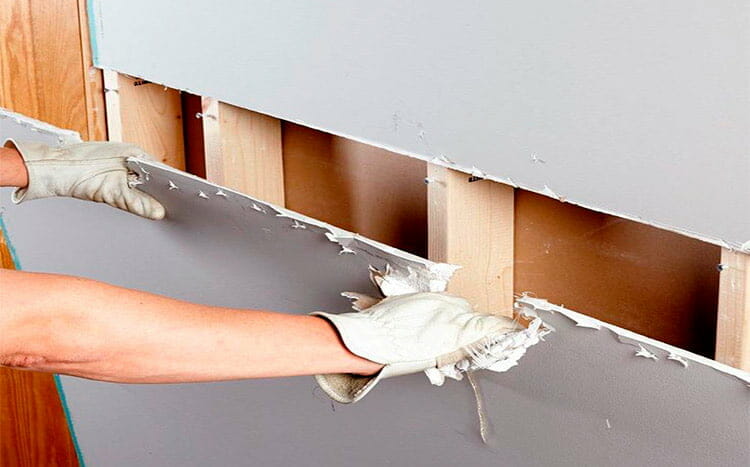Thinking about giving your walls a makeover but hate the thought of the mess and expense that tearing down old drywall brings? Guess what, there’s a **cool tip** for you: just put the new drywall directly over the old one. Get ready to see your space change without the chaos or breaking the bank. This method is a real time-saver and a sanity preserver during home makeovers. Perfect for homeowners craving a quick and easy update, it’s like a hidden passage to a new aesthetic minus the usual demolition disaster. Hang tight to discover the simplicity and efficiency of this technique.
Yes, it is ok to drywall over drywall. It is cheaper than ripping out the old drywall and is also great for soundproofing and insulating the walls. You will re-jig a few fixtures, such as electrical outlets and kick-boards.
Here is what you should know about installing drywall over drywall.
Is it better to remove old drywall?

No, it is generally not better to remove old drywall. This is because installing new drywall over old drywall is a faster method of remodeling. Removing drywall is usually tedious and physically taxing. When doing so, you also have to worry about the pollution component of the removal process. There is also the fact that you have to figure out how to dispose of the debris.
Therefore, as far as convenience and speed of installation are concerned, installing new drywall over old drywall is a better option. It is also better in terms of costs especially if you decide to hire contractors. This is because they won’t charge you the cost of drywall removal and debris disposal.
However, there are times when it is advisable to remove old drywall before installing new drywall. The following are some of them.
- When dealing with mold problems and the old drywall has extensive mold growth, then removing it is better. This is because placing new drywall over it will simply make the problem worse. It will reduce air circulation, increase the odds of the air between the drywalls getting highly humid, and accelerating the mold problem. It will also make it harder to kill and get rid of the mold if it comes back.
- If the old drywall is damaged to a point where it is literally falling off, then it is advisable that you remove it completely.
- If you need to update your wiring and insulation, and you have the time and money to do it at the time of installation, you might as well remove the wall and do the update before installing new drywall. This will make it easier for you to make the installation, and so you can kill two birds with one stone.
- Old drywall sometimes makes it very challenging to locate studs. Therefore, if you are having a hard time locating studs, even with a stud finder, then you can remove old drywall. This will make screwing the new wall into place much easier.
Problems with the second layer of drywall
When you are trying to install the second layer of drywall, you are bound to run into a few challenges. Why? Because you will be adding an extra ¼” to the thickness of your walls. This will present problems in terms of how items that are attached to your walls will look.
It may also present functional challenges in that fixtures and other items may not function as well as they should when once you add the extra thickness. And as a result, in most cases, simply attaching new drywall to the old drywall is never enough. Here are some of the problems that you are bound to come across.
Power outlets on walls
Since your power outlets were installed with the old drywall in mind, the installers likely took extra steps to make sure that they were a perfect fit. Unfortunately, when you install new drywall over the old one, you are changing the dimensions of the wall as far as thickness is concerned. You are essentially adding a quarter of an inch of thickness.
As a result, the outlet won’t be as flush, as far as fitting in place is concerned. This will create an uneven and unsightly look that can be a little bit frustrating. The good news is that this is a problem that is easy to solve. All that you will have to do to get the outlets looking like they belong is to buy extensions for the outlets and then install them.
Door and window trim
Typically, window trims and door casings stick out. This is something that is not only normal, but also gives the doors and windows an appealing look. Therefore, when you simply slap on an extra layer of ¼” drywall, you will make these features stick out less. What you will end up with is trim that looks both awkward and sunken.
To avoid creating this awkward look, it is always advisable that you remove window and door trims before the installation of the new drywall. And it is only after you are done installing the second drywall that you should then reinstall the trim. Doing so with extensions that have the same thickness as the added drywall will prevent the awkward-looking appearance in cases where drywall is installed over existing drywall.
Floor skirting
Good skirting enhances the look of a room. It also helps to shield the wall from accidental furniture scratches. And it also covers any imperfections in the edges of the floor or walls. Therefore, if you simply install the second drywall over it, you will be essentially rendering it useless.
It is always recommended that you remove floor skirting before installing the second drywall. You can then reinstall the skirting right after you are done with your drywall installation.
Studs
While there are similarities between installing the second drywall and the initial one, one main difference you will notice will be the difficulty in locating studs. With the second installation, the first drywall will be covering the studs. You won’t be able to see them. And since you need to fasten the new drywall onto the studs if you want a sturdy installation, locating them is a must.
One of the best ways of locating studs that are behind a drywall is to use a stud finder. While it will cost you money, this will simplify the stud-finding process and thus save you time.
If you don’t want to spend any extra money, you can use the tracing method. With this method, you will locate the location of the studs by following the screw placement of the initial drywall installation. Since the old drywall was also installed by securing it to the studs, you can reliably tell where the studs are located by following them.
You then create marks on the ceiling indicating the location of the vertical studs, and you can thereafter rely on these markers to tell where they are located.
Can I put drywall over damaged drywall?
Yes, you can put drywall over damaged drywall. This is so especially if what you are dealing with are steans, cracking, or chipping.
However, if the old drywall is so damaged to a point where it is almost falling off, then removing it is advisable. The headache of trying to overcome the deficiencies of a structurally compromised drywall, in addition to the fact that having it in place will make finding studs and screwing the new walls harder, is not worth the time or effort.

Will another layer of drywall help prevent mold?
No, another layer of drywall will not help to prevent mold. In fact, it may make your mold problem worse because it creates an enclosed area with poor aeration. Furthermore, if mold develops in the inner wall, getting rid of it will be a little harder than it would have been.
To prevent mold, all you need to do is to regulate humidity in your home, avoid moisture spills, and kill off any mold that develops as soon as possible.
What thickness drywall for the second layer?
For the second wall, ¼” drywall is usually recommended.
Finding a good drywall contractor
If you need help with your drywall installation, hiring a good drywall contractor is the best option. And the easiest and fastest way of finding qualified experts that meet your needs is to use HomeGardenGuides.com. It offers a free service that quickly matches you with the top-voted local experts.
Using the website, you can get 3 estimates fast by real certified experts in your area in just 2 minutes. Here is how it works.
- You scroll to the top of the page and enter your Zip code.
- Answer questions about your drywall remodeling project
- Your details will be forwarded to three local experts.
- You will then receive a price estimate for the job and some friendly advice.
IMPORTANT: There is no obligation to hire. This is a free tool and service to be used at your pleasure.

FAQ's
Is it ok to hang drywall vertically?
Yes, it is ok to hang drywall vertically. In fact, in commercial establishments, it is sometimes required.
However, as far as residential houses are concerned, hanging drywall horizontally is recommended. This is because it not only makes for sturdier installations but also enables you to do the work faster and without necessarily needing an extra set of hands to get it done.
How much does a drywall contractor charge?
On average, a drywall contractor will charge between $0.5 to $0.75 per square foot for their services.
Should I use ½ or ¼ inch drywall?
When you are installing drywall over drywall, you should use ¼” drywall.
Should I drywall ceilings or walls first?
You should always drywall ceilings first because it will make for a stress-free installation. Furthermore, when you start with the ceiling, you have a better chance of ending up with tighter and neater joints.






